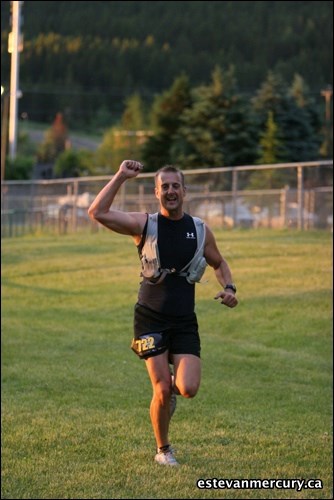To finish off the Sinister 7, Lloyd Sehn first had to conquer a sinister 1,040.The Estevan distance runner had been assigned to the final segment of the seven-leg ultra-marathon, which took place July 10 in the Rocky Mountains near Blairmore, Alta.His first task? A 1,040-foot vertical climb over a distance of two kilometers to the top of Wedge Mountain."The first two kilometers I was out of gas," Sehn said in an interview Thursday. "By the time I got to the top of the mountain my legs were rubber. They felt like Jello. My lungs were burning and by the time I got to the top I felt like quitting already."He didn't, though, and went on to finish his 12-km section of the 146-km relay-style race with time to spare.Not that he knew it at the time."Coming into transition area six I knew I had a lead but I didn't know how much of a lead," said Sehn, "so when I took the timing chip and started onto my leg, of course your mind plays tricks on you."And through the entire Leg 7 I could hear footsteps in behind me. I would keep looking back to hear that runner coming behind me but of course there never was a runner there."When I crossed the finish line of course we did a celebration and I was a little surprised to find out it was 20 minutes later before the next person came through."***A little over three years ago, Sehn wasn't running at all. July 10 he was a winner in his first-ever ultra-marathon.Sehn's seven-person team crossed the finish line in 14 hours 18 minutes 43 seconds, beating out 91 other teams."It was a bit of a surprise for us," he said. "Sort of one of those lifetime cherishing moments where you'll remember that day forever. And the ability to actually win an ultra-marathon, words can't describe that feeling."The journey began last December when Sehn was asked by a co-worker from Camrose, Alta. if he would consider challenging the Sinister 7.By January a team of seven runners -one for each leg of the race -had been assembled and the training began in earnest for an adventure unlike anything Sehn had experienced."It's very intimidating," he said. "You are literally working with 19,000 feet in elevation gains and drops. You're in the wilderness. You're up mountain sides and down in the forest."You're trying to follow little ribbons, little painted rocks along the way, so the navigation is key. And you're competing against some very, very incredible runners out there so it was pretty intimidating for those of us who had never done this kind of event before."The race's website states also that competitors are affectionately known as Sinners, and that they are required to carry, at a minimum, a head lamp, toque, whistle, wind jacket, and space blanket.Sehn had completed two standard full marathons and several half-marathons prior to the Sinister 7 but had limited opportunity to simulate the conditions he encountered in Alberta."We don't have a lot of mountains to climb here," he said with a laugh. "My last training run prior to going was a 26-kilometre highway run through the Moose Mountains and it covered off 13 hills on the course, and that's almost as much as you can do here."Race day proved even more demanding than Sehn had thought possible."There were a lot of people that were physically ill and physically sick both during and after the event," he said, noting that group included himself.The night before the race, Sehn's team plotted out their strategy. All had run standard marathons in the past and two had completed similar ultra-marathons as well.Using information about the course's terrain and elevation, along with each runner's past experience and marathon times, they attempted to place each runner in a leg that would best suit their strengths.The preparation was invaluable."We may not have been the fastest team, but we were the most prepared and then we executed perfectly," said Sehn.




